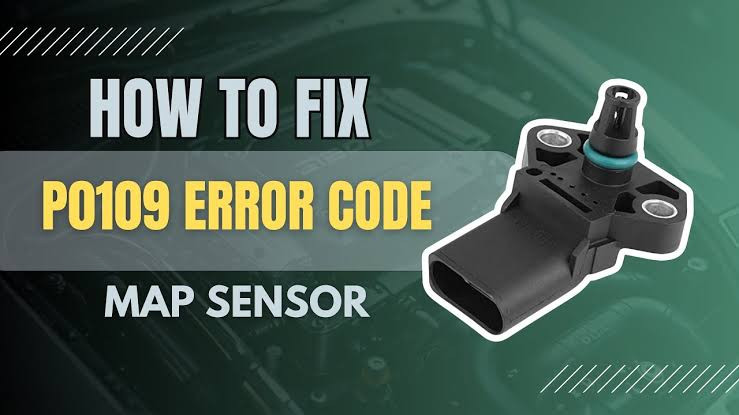In the world of automotive diagnostics, few things are more frustrating than an intermittent problem. According to recent data, nearly 35% of all check engine lights involve sensor-related issues, with the MAP sensor being among the most common causes.
When your vehicle throws a P0109 code, it's telling you something critical about how it breathes, and ignoring it could be costly.
What is MAP?
Every time you press your accelerator pedal, a complex dance of air, fuel, and electronics takes place under your hood. At the heart of this performance is the Manifold Absolute Pressure (MAP) sensor, a small but mighty component that constantly measures air pressure in your engine's intake manifold.
Think of the MAP sensor as your engine's barometer. It provides crucial real time data to your vehicle's Electronic Control Module (ECM), helping it determine the perfect air-fuel mixture for optimal performance. When this sensor starts providing inconsistent readings, which is exactly what the P0109 code indicates, your engine begins making critical decisions based on flawed information.
"In my 20 years of diagnostics, I've found that intermittent sensor issues like P0109 are often overlooked because the vehicle might seem to run fine most of the time," says automotive specialist Mark Reynolds. "But make no mistake, your engine is quietly suffering."
The Warning Signs
Your car communicates its distress in various ways when dealing with a P0109 code. You might notice:
- Unpredictable engine performance, strong one minute, sluggish the next
- A rough, inconsistent idle that comes and goes
- Unexpected hesitation during acceleration
- Gradually worsening fuel economy
- An illuminated check engine light that may occasionally turn off on its own
What makes this code particularly tricky is its intermittent nature. Unlike consistent problems, an intermittent MAP sensor issue might only act up under specific conditions, perhaps during cold mornings, on humid days, or when accelerating at highway speeds.
Diagnosing P0109
Getting to the root of a P0109 code requires methodical investigation. While professional diagnostic equipment provides the most accurate results, here's how the process typically unfolds:
1. Verification: The first step is confirming the code with an OBD-II scanner. Pay attention to any other codes that appear alongside P0109, as they may provide additional clues.
2. Visual inspection: Many MAP sensor issues stem from physical problems. Check for:
- Damaged wiring and connectors.
- Loose connections
- Vacuum hose leaks or cracks
- Signs of moisture or contamination
3. Electrical testing: Using a multimeter to test the sensor's voltage output can reveal if it's producing consistent signals. A properly functioning MAP sensor should produce:
- Approximately 4.5 - 5.0V with the key on but engine off
- Variable readings between 1.0 - 4.5V while the engine runs, changing with RPM
4. Vacuum testing: Since the MAP sensor measures pressure, a comprehensive vacuum leak test can uncover hidden issues in the intake system.
Common Causes of P0109
After diagnosing hundreds of vehicles with this code, I've found these are the most frequent culprits:
- Wiring issues: Damaged, corroded, or loose wiring connections are the leading cause. These problems create intermittent electrical connections that confuse your ECM.
- Faulty MAP sensor: The sensor itself can fail, especially after years of exposure to heat cycles and engine vibration.
- Vacuum leaks: Small cracks in vacuum lines, the intake manifold, or gaskets can create inconsistent pressure readings.
- Water or oil contamination: Moisture or oil entering the sensor can cause erratic readings.
- ECM problems: Though less common, the engine computer itself might occasionally misinterpret signals from a properly functioning sensor.
The Fix
Addressing a P0109 code typically involves one or more of these solutions:
- Repair wiring issues: Often, carefully inspecting and repairing damaged wiring resolves the problem. Pay particular attention to the connection points, which are vulnerable to corrosion.
- Replace the MAP sensor: If the sensor itself is faulty, replacement is necessary. Most MAP sensors cost between $50 - 200, with labor adding another $50 - 100 if you can't handle the job yourself.
- Fix vacuum leaks: A professional smoke test can reveal invisible leaks in your intake system. Replacing damaged vacuum lines or gaskets often solves the issue.
- ECM updates: In rare cases, your vehicle might benefit from an ECM software update that better handles signal variations.
DIY or Professional Help?
For mechanically inclined owners with basic diagnostic tools, addressing visible wiring issues or replacing a MAP sensor is often within reach. However, diagnosing intermittent problems can be challenging even for professionals.
"The trickiest part of P0109 isn't replacing parts, it's definitively identifying the cause," explains certified technician Sarah Chen. "I've seen countless vehicles come in after owners replaced the MAP sensor unnecessarily, only to find the real issue was a pinched wire or vacuum leak."
If you're tackling this yourself, invest time in thorough diagnosis before replacing parts. A multimeter, vacuum gauge, and OBD-II scanner with live data capabilities are invaluable tools.
Prevention
While some sensor failures are inevitable with age, these practices can extend the life of your MAP sensor and related components:
- Maintain a clean air filter to reduce contaminants reaching the intake system
- Address vacuum leaks promptly
- Keep electrical connections clean and protected from moisture
- Follow manufacturer-recommended maintenance schedules
The P0109 code might seem like a minor inconvenience when it first appears, but it signals a condition that gradually compromises your engine's performance, fuel economy, and potentially its longevity. By understanding what this code means and addressing it promptly, you'll ensure your engine continues to breathe, and perform, exactly as its engineers intended.
Remember that successful diagnosis often requires patience and methodical testing. Whether you choose to tackle this issue yourself or seek professional help, addressing the root cause rather than simply clearing the code will save you money and frustration in the long run.

Comments (0)
Please login to join the discussion
Be the first to comment on this article!
Share your thoughts and start the discussion